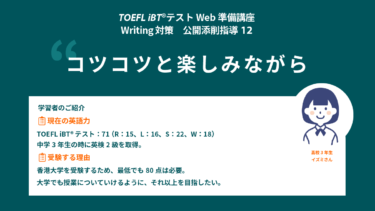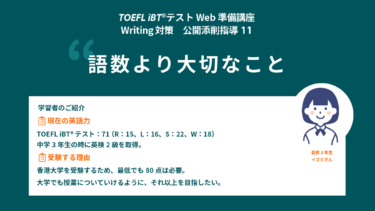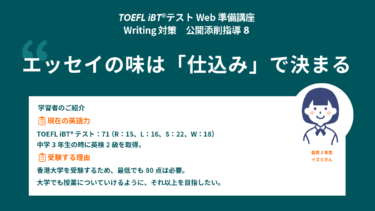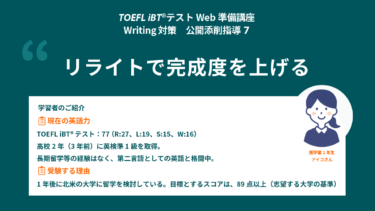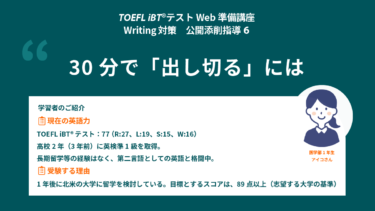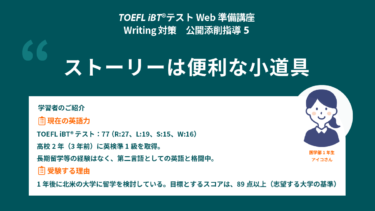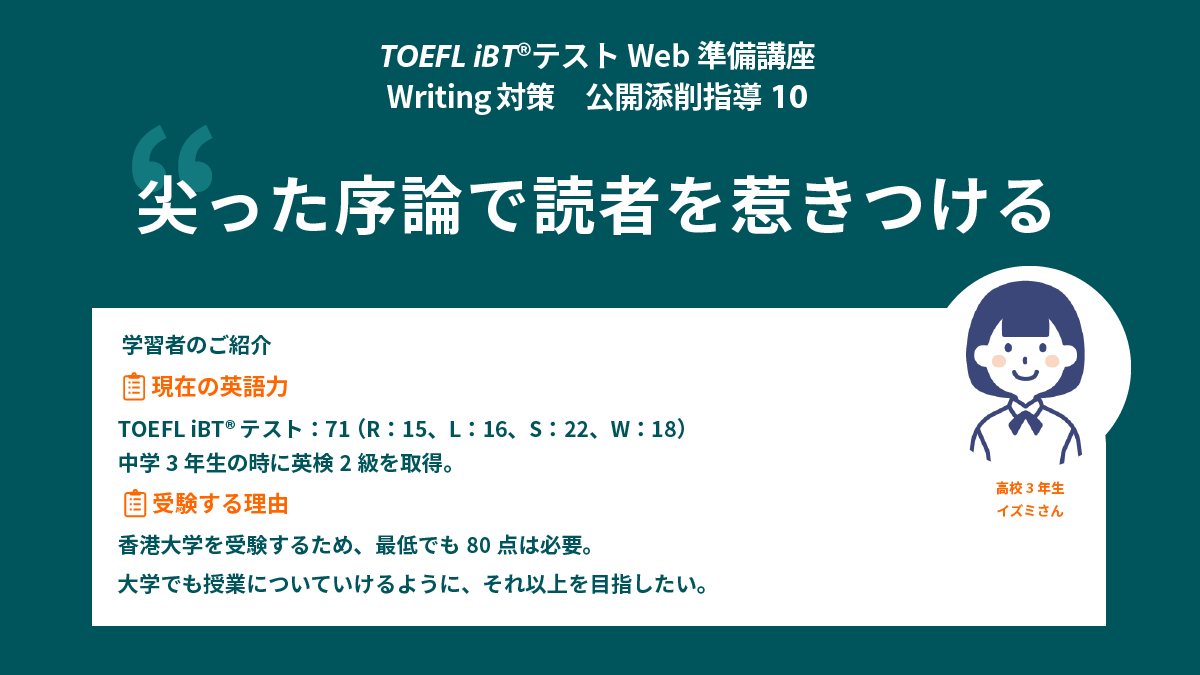
みなさん、こんにちは。TOEFL iBT®テストWeb準備講座を担当するETS公認トレーナーの横川綾子(よこがわあやこ)です。日本では4月から新しいacademic yearが始まる学校がほとんどですね。この時期、「あけましておめでとうございます」と挨拶を交わす先生方もいて面白いです。 面白いと言えば、私が勤務する東京海洋大学でウミガメのはく製を運んでいる学生達を見ました。「うみがめ研究会(通称かめ研)」による新入生勧誘の一コマでしたが、微笑ましい光景にウミガメ好きの私も思わず入会したくなりました。

イズミさん
現在の英語力
中学3年生の時に英検2級を取得。進研模試やセンター試験の英語の偏差値は75以上、リスニングは80以上。アメリカの高校に2014年9月から通っている。初めて受けた2015年1月のTOEFL iBTテストの結果は71点(R:15、L:16、S:22、W:18)。
TOEFL iBT®テストを受験する理由
香港大学を受験するため、最低でも80点は必要。大学でも授業についていけるように、それ以上を目指したい。
TOEFL iBT®テストの学習で困っている点や悩んでいる点
独学なので購入したテキストを使い格闘している。短時間でスコアを上げたいので、最低でも押さえておくエッセイのポイントや幼稚にならない書き方が知りたい。
留学したい理由
大学で英語を学ぶのではなく、大学で英語を使って、つまり英語を手段として専門的な内容を学びたい。アジアの最高レベルと言われている大学で、アジアと世界のつながりを学びたいと思っている。
英語学習全般での課題や質問
ボキャブラリーが少なく、単語を覚えるのが苦手。スピーキングでは、緊張してしまい、正しく整理された文法を使って、決められた時間で話すことが苦手。
ブレーンストーミングから始めたこの課題でしたが、いよいよエッセイを完成させる段階に来ました。イズミさんは前回記事(第9回 自分にとっての当たり前≠人にとっての当たり前 )でのフィードバックを参考に、3つのパラグラフを改良、その前後に序論と結論を足して5パラグラフエッセイを仕上げました。校正に関しては「第1回 エッセイライティングのポイント 」掲載の校正チェックリストを参考にしてもらいました。
エッセイのテーマ
Do you agree or disagree with the following statement? Face-to-face communication is better than other types of communication, such as letters, e-mail, or telephone calls. Use specific reasons and examples to support your answer.
以下の主張に賛成ですか、反対ですか。対面でのコミュニケーションは、手紙、Eメール、電話といった他のコミュニケーション方法よりも優れている。自分の意見の根拠となる特定の理由と例を用いなさい。
課題
エッセイを完成させます。リライトした3つのパラグラフの前後にIntroduction とConclusionに相当するパラグラフを1つずつ追加して、5パラグラフエッセイに仕上げてください。語数は300ワード前後が目安です。
イズミさんのエッセイ
I agree that face-to-face communication is better than other types of communication, because it’s easy to express our feelings quickly, there is less misunderstanding and it’s the best way to build relationships.
First, we use body language only in face-to-face communication. It is an easy way to express our feelings quickly. I think the most important part of communication is conveying our exact emotions to someone. It’s hard to express our feelings in spoken language, but it’s easy to do it in face-to-face communication. When we feel happy and comfortable, we smile automatically. We don’t use any words. Also, body language can emphasize your feelings. We are always using it to show how happy or sad we are. Last week, my friend told me that she passed her college entrance exam. I was so happy to hear that. I literally jumped up and got her a big hug. This may be the same as saying “Congratulations!” to her, but it showed how happy I was and also made her happier that just saying “Congratulations!”. The natural language of body really helps of expressing your feelings.
Second, there is less misunderstanding in face-to-face communication. During face-to-face communication, we respond and are replied to fast. Fast response makes the conversation go smoothly and there is less misunderstanding. If you don’t get the meaning of something, you can ask the person in front of you right away. Moreover, you can ask them to use other, simply words to make sure you understand the meaning immediately. Face-to-face communication is the best way to make sure you understand information.
Third, face-to-face communication helps to build relationships. One of the purposes of communication is developing a good personal relationship with others. In my experience, after talking to someone, I get to know the personality of the person. This makes building a relationship much easier. Face-to-face communication not only means that you are in the same space with someone and you are in eye contact with them, but you are sharing all the same things like feelings, atmosphere, time, weather and the experience together. It’s like making memory with someone. I can say, making memory is the same as building a good relationship. It’s clear that face-to-face communication is one of the best ways to build deep relationships.
In conclusion, the natural language of the body which only use in face-to-face communication helps of expressing our feelings. Also it’s the best way to make sure your understanding of information and build deep relationships. I think face-to-face communication is much better than others, and I would like to communicate with people in face-to-face as much as possible.
(439 words)
横川先生からコメント
イズミさんのエッセイは439ワードで量は十分、意味の理解を妨げる語法や文法のエラーもほとんどありません。このレベルのエッセイを初見のトピックで30分以内に書くことが、多くのTOEFL iBTテスト受験者にとって最初に目指すべき到達点の1つではないでしょうか。今回は趣向を変えて、言語面での校正を担当しているPaul Strifler氏にも内容に関するコメントをしてもらいます。パラグラフの添削例は記事の最後に掲載します。
第1パラグラフ
Strifler氏:
This introductory paragraph needs to be fleshed out more. The writer has to convince the reader that she believes in her opinion first. At least, one extra sentence is needed to show this “enthusiasm”. After the reader believes that the writer is ‘passionate’ about the topic, she can explain exactly why she is passionate. Listing the main points about why the writer is ‘passionate’ not only helps the reader prepare for what is coming next in the essay, but also builds interest for the reader to continue reading as the reader wants to learn more about the opinion of the writer.
横川先生:
序論となる第1パラグラフは、今回イズミさんが書き下ろしたものです。続く本論で論じる3つのポイントが簡潔に提示されていますが、Strifler氏が指摘するように若干無機質な印象を受けました。なぜその3つのポイントなのか(Strifler氏によれば”why she is passionate”)が伝わる背景説明の文が1つでもあると、読み手の興味をより惹きつけることができたでしょう。例えば「現代は何でもメールで済ます傾向があるが、それは良いことではないと思う」、「対面で話す機会は互いが意識してつくらないと得られないが、その手間をかける価値がある」など、書き手の主観をベースにした尖った世相批評のようなコメントがあってもいいですね。
第2~4パラグラフについて
Strifler氏:
In the body of this essay, the “first”, “second” and “third” ideas are explained at greater length; this was done very nicely and shows the unique viewpoint of the writer. This was well done.
横川先生:
本論にあたる第2~4パラグラフは前回記事でフィードバックした内容がしっかり反映されています。第2パラグラフにI think the most important part of communication is conveying our exact emotions to someone. という1文が挿入されたことで、イズミさんの論理展開を支える「軸」が構築されました。また第4パラグラフにはOne of the purposes of communication is developing a good personal relationship with others. が追加され、Topic sentenceとExampleをロジカルにつなぐ役割を果たしています。
第5パラグラフについて
Strifler氏:
In making a conclusion, the writer should not hesitate to explain once again and repeat the main points or ideas of the essay, even though the reader has already read it. This is the last chance for the writer to convince the reader that she is correct and logical in her conclusions on the topic. At the end of the conclusion, the writer has correctly supported her ideas and in this way encouraged the reader to adopt her way of thinking.
横川先生:
結論となる第5パラグラフも今回イズミさんが書き下ろした部分です。Strifler氏のコメントにあるように、イズミさんは序論で提示した意見をぶれずに再提示することで、書き手の主張を説明する最後のチャンスをしっかり自分のものにしています。今回の課題のように「本論を書いてから序論と結論を足す」という流れにすると、書きながら論旨がずれているミスを防ぐことができます。最後は決意表明で締めており、エッセイのメッセージ性が補強されました。
パラグラフの添削例
I agree that face-to-face communication is better than other types of [communication such as letters, email or talking on the telephone. These other forms of communication are used only when you cannot meet someone directly and so are obviously not the best way to communicate.] communication, because [There are at least three reasons why meeting someone face-to-face is better. First. when you meet someone,] it’s easy to express our [your] feelings quickly, [.] [Second,] there is less misunderstanding [,] and[; third,] it’s the best way to build relationships. [I will explain my point of view in more detail below.]
First, we use body language [is used] only in face-to-face communication. It is an easy way to express our feelings quickly [this way]. I think t[T]he most important part of communication is conveying our exact emotions to someone. It’s hard to express our feelings in spoken language, but [when using body language,] it’s easy to do it in face-to-face communication. When we feel happy and comfortable, we smile automatically. We don’t [need to] use any words. Also, b[B]ody language can [also] emphasize your feelings. We are always using [use] it to show how happy or sad we are. Last week, my friend told me that she passed her college entrance exam. I was so happy to hear that [the news]. I literally jumped up and got [gave] her a big hug. This may be the same as saying[,] “Congratulations!” to her, but it showed how happy I was and also made her happier [to receive a hug than] that just saying [hearing a word] “Congratulations!”. The natural language of [the] body really helps of expressing [to express] your [true] feelings.
Second, there is [when we use face-to-face communication, there is less] misunderstanding in face-to-face communication. During face-to-face communication, w[W]e respond and are replied to fast. [The] F[f]ast response [helps] makes the conversation go smoothly and there is less misunderstanding. I[i]f you don’t get [understand] the meaning of something, you can ask the person in front of you right away. Moreover, you can ask them to use other,simply [more simple] words to make sure you understand the meaning immediately. Face-to-face communication is the best way to make sure you understand information.
Third, face-to-face communication helps to build relationships. One of the purposes of communication is d[D]eveloping a good personal relationship with others [is one of the purposes of communication]. In my experience, after talking to someone, I get to know the personality of the person [better]. This makes building a relationship much easier. Face-to-face communication not only means that y[Y]ou are [not only] in the same space with someone and you are in eye contact with them, but you are sharing all the same things like feelings, atmosphere, time, weather and the experience together. It’s like making [a] memory with someone.[,] I can say, making memory is the same as [and it helps] build a good relationship [with them]. It’s clear that face-to-face communication is one of the best ways to build deep relationships.
In conclusion, [face to face communication helps us] of expressing [express] our [true] feelings [quickly, using] the natural language of the body which only use in face-to-face communication helps of expressing our feelings. Also i[I]t’s [also] the best way to make sure your [you] understanding of [understand the] information [being conveyed to you because you can ask questions and get the answers immediately]. [Finally, it helps us get to know the personality of someone better] and [in this way] build [a] deep relationship [with them because you are collecting the experience of a shared memory together]. I think face-to-face communication is [the best] much better [way to communicate] than others, and I would like to communicate with people in face-to-face as much as possible.
英文校正協力:Paul Strifler
いかがでしたか。エッセイはscholarly pieces of writing giving the author’s own argumentとも定義される、自分の主観を披露する文章です。読み手がその根拠や背景を推測でき、本論とのつながりが感じられるのであれば、序論で多少尖った主張をするのも印象的なエッセイを書くコツの1つではないでしょうか。では次回(第11回 語数より大切なこと)お会いしましょう。

横川綾子先生
明治大学 国際連携機構 特任教授
ETS Authorized Propell® Facilitator
ETS TOEFL ITP® Teacher Development Workshop Facilitator
上記は掲載時の情報です。予めご了承ください。最新情報は関連のWebページよりご確認ください。
学習サポート・関連情報
★テスト受験までの8週間サポート★

初めてTOEFL iBT®テストを受験される方のうち、次の対象者には週1回✖️8週間 の受験支援メール配信とTOEFL iBT® Test Prep Plannerの無料配送を行っています。
対策塾などに通わず、独学で勉強されている皆さん、「TOEFL®テストの勉強は孤独・心配・不安…」と感じていませんか?
ETS Japanは、8週間サポートを通じて、学習計画の立て方や、勉強に必要な情報の探し方をお手伝いします。目標スコア獲得に向けて受験日まで一緒に進んでいきましょう!
★公式教材を利用して目標スコアを目指そう★

目標スコア別に公式教材を利用した学習法を教材ショップのスタッフがご提案。学習の目安や各教材ごとの学習方法など、ぜひ参考にしてください。

Performance Descriptors for the TOEFL iBT® test
各セクションは0~30のスコアで評価され、そのスコアに応じて4または5段階のレベルに分けられます。このレベルはTOEFL iBT®テストにおけるCEFR levelを反映しています。
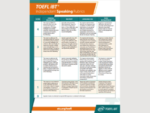
TOEFL iBT®テスト スコアガイド(Speaking)
Speakingセクションの採点基準です。上記の「Performance Descriptors for the TOEFL iBT®test」と併せてご活用ください。
SpeakingはETSが公表しているスコア基準表に沿って採点されます。採点基準はIndependent Task用・Integrated Task用にそれぞれ作成されており、Delivery(話し方)/Language Use(語彙の使い方)/Topic Development(トピックの展開)の大きく3つのポイントに分かれています。
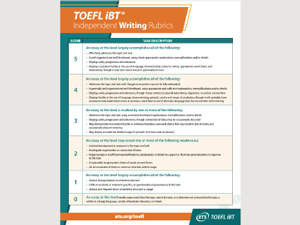
TOEFL iBT®テスト スコアガイド(Writing)
Writingセクションの採点基準です。上記の「Performance Descriptors for the TOEFL iBT® test」と併せてご活用ください。
Writingに関してもETSが公表しているスコア基準表に沿って採点されます。採点基準はIndependent Task用・Integrated Task用にそれぞれ作成されています。

英語圏の大学・機関だけでなく、世界の大学・機関で、公式スコアとして留学や就活などに活用されています。コンピュータ上で受験し、スピーキングは回答音声をマイクを通して録音、ライティングはタイピングで回答します。

自宅受験TOEFL® Essentials™テスト
2021年から自宅受験型の新しいテストとしてリリースされました。約90分の試験時間、短い即答式タスクが特徴のアダプティブ方式の導入されています。公式スコアとして留学や就活などにご利用いただけます。

TOEFL ITP®テストプログラムは、学校・企業等でご実施いただける団体向けTOEFL®テストプログラムです。団体の都合に合わせて試験日、会場の設定を行うことができます。全国500以上の団体、約22万人以上の方々にご利用いただいています。



